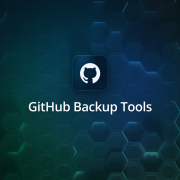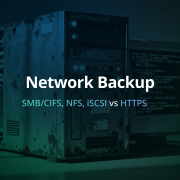
Granular Recovery Technology: How Does It Work and What Do You Need to Know About It
In the modern office environment, every person working on projects generates huge amounts of data. Emails, datasheets, presentations, databases, documents, and many many more. Protecting this information is very important from the business standpoint, so usually, organizations tend to use backups as the mean of protecting their data. But backup is only one part of the equation. What would you do if somehow you lose that data? Well, you probably want to quickly and easily recover it. Then you should think about setting up a granular recovery (alt. granular restore) plan which is also the main topic of this article.
What is granular recovery technology?
Granular recovery or in the more technical term – Granular Recovery Technology – is one of the methods of recovering data from backup copies. With granular recovery, you are able to selectively choose which data to recover. In other words, granular recovery allows recovery of files on the individual level, without the need for a full recovery.
Where many backup solutions need to create multiple copies to recover in both granular (individual files or directories) and full (entire systems) ways, Granular Recovery Technology allows recovering specific files in seconds, as well as the whole systems from a single backup.
How does granular recovery work
To better understand how granular recovery works let’s analyze a specific use case.
Let’s say that our user has a computer with two hard drives. One morning one of them suddenly fails – breaks down, or simply gets destroyed.
On that hard drive, important files were stored, but you – the Admin – have created a backup plan for this device, so the data is not lost. Now you just need to recover those files as fast as possible – having in mind that the shorter the business downtime will last, the better. This means that you need to prioritize the recovery of the critical files, and then work your way through the less critical ones.
With a backup solution allowing a granular restore, like Xopero ONE, you can easily search for important files within the backup you created, mark them, and get them recovered with a few clicks, to a new location. It could be for example the new working drive, while the rest of the backup data remains untouched.
Does granular recovery address disaster recovery issues?
Granular Recovery Technology is the key to solving most issues of disaster recovery. Due to the fact that with it there is a way of fast recovery of mission-critical data. Where the full image backup restore is an option for full recovery of the systems, it might be troublesome because the longer restoration times translate to longer downtime of the organization. Granular recovery provides another faster option to recover the data promptly.
Granular Restore: Recovering Specific Data
Granular restore is a standout feature of granular recovery technology that empowers users to recover specific data from a backup without the need to restore the entire system or dataset. This capability is particularly valuable in scenarios where only a small portion of the data is needed, saving both time and effort during the recovery process.
With granular restore, users can navigate through the backup data using a user-friendly interface, such as a file explorer or a restore wizard. This allows them to pinpoint and select the specific files or folders they need to recover. Once selected, the granular restore feature swiftly retrieves the chosen data, bypassing the need for a full system recovery.
The benefits of granular restore are manifold:
- Faster recovery times: By focusing only on the specific data required, granular restore significantly reduces the time needed for the recovery process.
- Reduced storage space: Since only the necessary data is stored and recovered, granular restore optimizes storage space, making it a more efficient solution.
- Improved data protection: Granular restore adds an extra layer of data protection, ensuring that critical files can be quickly recovered in the event of data loss or a disaster.
In essence, granular restore enhances the overall efficiency and effectiveness of granular recovery technology, making it an indispensable tool for modern data protection strategies.
Backup Data: Best Practices for Granular Recovery
Effective backup data management is crucial for the success of granular recovery technology. To ensure that your backup data is reliable and ready for granular recovery, consider the following best practices:
- Regular backups: Schedule regular backups to maintain a current and accurate copy of your data. This ensures that you always have the latest version available for recovery.
- Data validation: Regularly validate your backup data to confirm its accuracy and completeness. This step is essential to avoid any surprises during the recovery process.
- Storage management: Efficiently manage your storage space to ensure that backup data is stored in an organized and accessible manner. This helps in quick retrieval during granular recovery.
- Data retention: Establish clear data retention policies to determine how long backup data should be kept. This ensures compliance with regulatory requirements and optimizes storage usage.
By adhering to these best practices, organizations can enhance the reliability and efficiency of their backup data, making granular recovery a seamless and effective process.
Applications of Granular Recovery Technology
Granular recovery technology finds applications across a wide range of industries, offering tailored solutions for various data recovery needs. Here are some notable examples:
- Microsoft Active Directory: Granular recovery technology can be used to recover specific elements from Microsoft Active Directory, such as user accounts, groups, and permissions. This ensures that critical directory information can be restored quickly without affecting the entire system.
- Microsoft Hyper-V: For environments using Microsoft Hyper-V, granular recovery technology enables the recovery of specific virtual machines and virtual hard disks. This allows for targeted recovery of virtualized resources, minimizing downtime and disruption.
- Data protection: Granular recovery technology plays a vital role in data protection strategies by providing a reliable method to recover specific data in the event of data loss or a disaster. This ensures that critical information is always safeguarded.
- Disaster recovery: In the face of natural disasters or cyber attacks, granular recovery technology offers a swift and efficient way to recover specific data, reducing the impact on business operations and ensuring continuity.
By leveraging granular recovery technology in these applications, organizations can enhance their data protection and disaster recovery capabilities, significantly reducing the risk of data loss.
Benefits of using granular recovery
We have already mentioned some benefits of using a granular recovery technology, but let’s talk about them a little more.

You or your IT team have great control over the backups and restoration processes, which is probably the most important benefit of using granular recovery with your backups. With it, you are able to choose exactly which files you want to recover and which you don’t, especially when you don’t want to perform a full recovery of your systems or virtual machines, you can just pick several items and recover them.
The other great benefit of using granular recovery is its speed. If you are to retrieve only selected items from a backup, there is no doubt that it would be faster than the traditional full restore. Granular recovery is much more efficient than full recovery, and because of its speed and efficiency, many companies rely heavily on granular recovery technology.
Granular recovery vs. basic data restore
But why choose granular recovery technology, over a simple full backup recovery? Let’s look a the difference between the old way – full restore – and the new one – granular restore.
Full backup restore is quite an easy process, enabling restore with just a few steps, and the big advantage is that you are able to recover the full data set from the backup in one go. But there are some problems with the way the full backup recovery functions. And the problems are quite easy to see in the case of VMware.
With the traditional backup of VMware, if you wished to recover individual files, you would need to have two instances of backup in place – one for the VM, and the other for individual files. You would need to recover the whole VM, and only then restore the files. With that comes a greater cost, due to greater storage space required, and longer time needed to recover the data. Granular recovery allows for the recovery of specific files or folders without the need to restore the entire virtual machine, saving time and reducing downtime during critical recovery scenarios.
With the granular restore, you would be able to restore individual files from the VMware backup within seconds, with the added bonus of requiring only one backup of your VMware, which saves storage space, and money on the backup licenses.
Implementing Granular Recovery: Key Considerations
Implementing granular recovery technology requires careful planning and consideration of several key factors to ensure its effectiveness. Here are some critical aspects to keep in mind:
- Data protection: Integrate granular recovery technology into a comprehensive data protection strategy. This ensures that your data is safeguarded against various threats, including disasters and data loss.
- Storage management: Efficient storage management is essential for granular recovery. Ensure that backup data is stored in a way that allows for easy access and quick recovery of specific files.
- Data retention: Establish clear data retention policies to determine the appropriate duration for keeping backup data. This helps in managing storage space and complying with regulatory requirements.
- Recovery process: Plan and test the recovery process thoroughly. This includes simulating different disaster scenarios to ensure that specific data can be recovered quickly and efficiently when needed.
By addressing these key considerations, organizations can implement granular recovery technology effectively, ensuring that they can recover specific data swiftly and minimize the impact of data loss or disasters.
Conclusions
Granular recovery revolutionized the way we restore data and is now a standard in every backup solution. In many ways, the granular restore can help us reduce downtime, and focus more on our projects. And with Xopero One you can utilize all the benefits of granular restore, with its speed, flexibility, and control, no matter what you need to protect, VMware, Microsoft 365, Git repositories, or and data in general. Find out yourself – start 14 days free trial







